A Comprehensive Analysis of the Humanities Secondary Curriculum
VerifiedAdded on 2022/12/23
|13
|3071
|24
Homework Assignment
AI Summary
This assignment presents a comprehensive analysis of a humanities secondary curriculum, focusing on history education within the Australian and Victorian curriculum frameworks. The document begins by defining history and its significance, emphasizing its role in understanding the past, present, and future, and its importance in fostering critical thinking and inquiry skills. The curriculum's rationale, aims, and objectives are outlined, including fostering interest in historical studies, developing historical inquiry skills, and understanding key historical concepts. The assignment also details the curriculum's objectives, including knowledge, skills, and values. It explores key concepts such as change and continuity, cause and effect, and perspectives. A lesson plan template is provided with a focus on the Mongol empire, outlining learning outcomes, assessment methods, and lesson procedures. Furthermore, the curriculum addresses general capabilities such as digital technologies, critical and creative thinking, literacy, and numeracy, as well as personal and social capabilities, ethical and intercultural understanding. The document concludes by highlighting cross-curriculum priorities like Aboriginal and Torres Strait Islander histories, Asia and Australia's engagement with Asia, and sustainability, all within the context of an 8th-grade level.
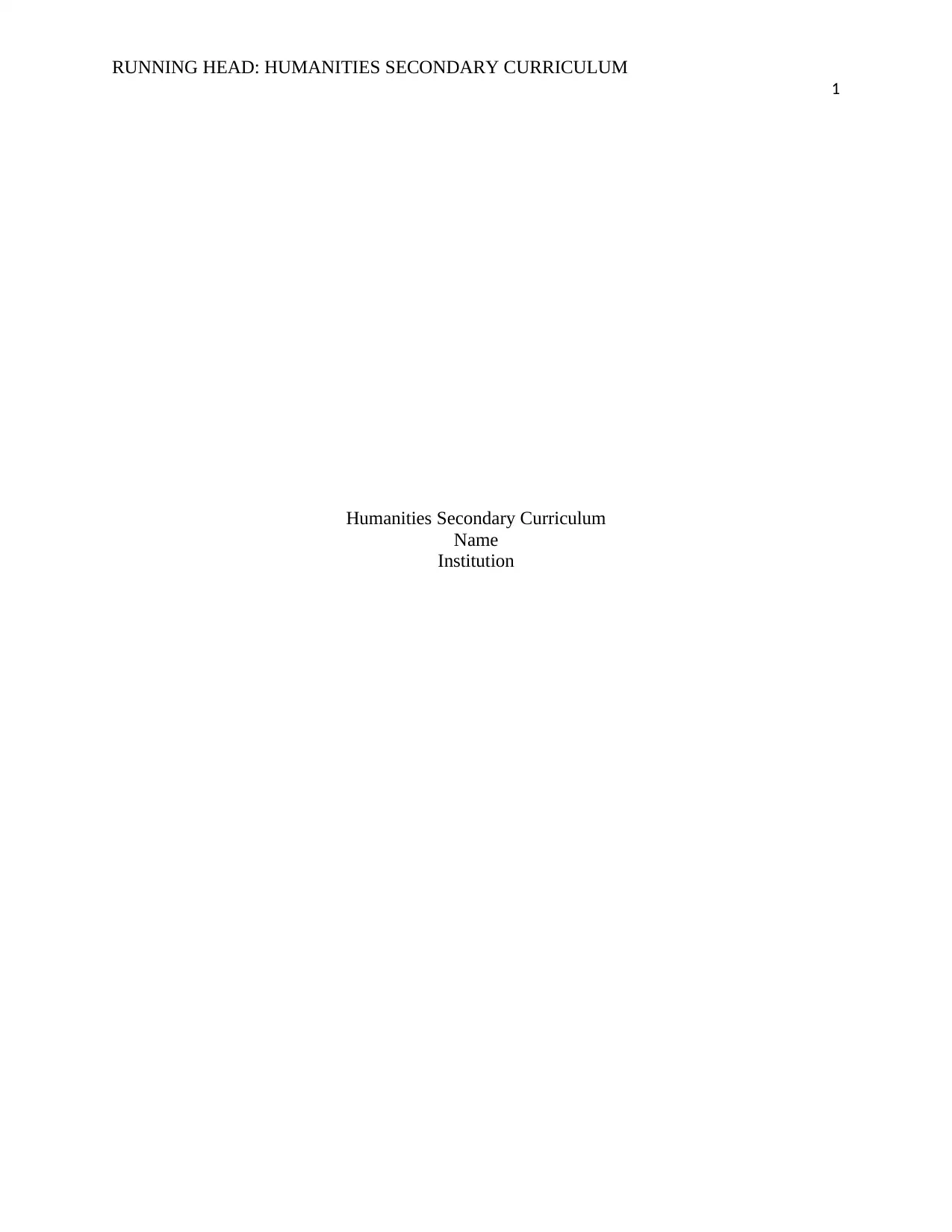
RUNNING HEAD: HUMANITIES SECONDARY CURRICULUM
1
Humanities Secondary Curriculum
Name
Institution
1
Humanities Secondary Curriculum
Name
Institution
Paraphrase This Document
Need a fresh take? Get an instant paraphrase of this document with our AI Paraphraser
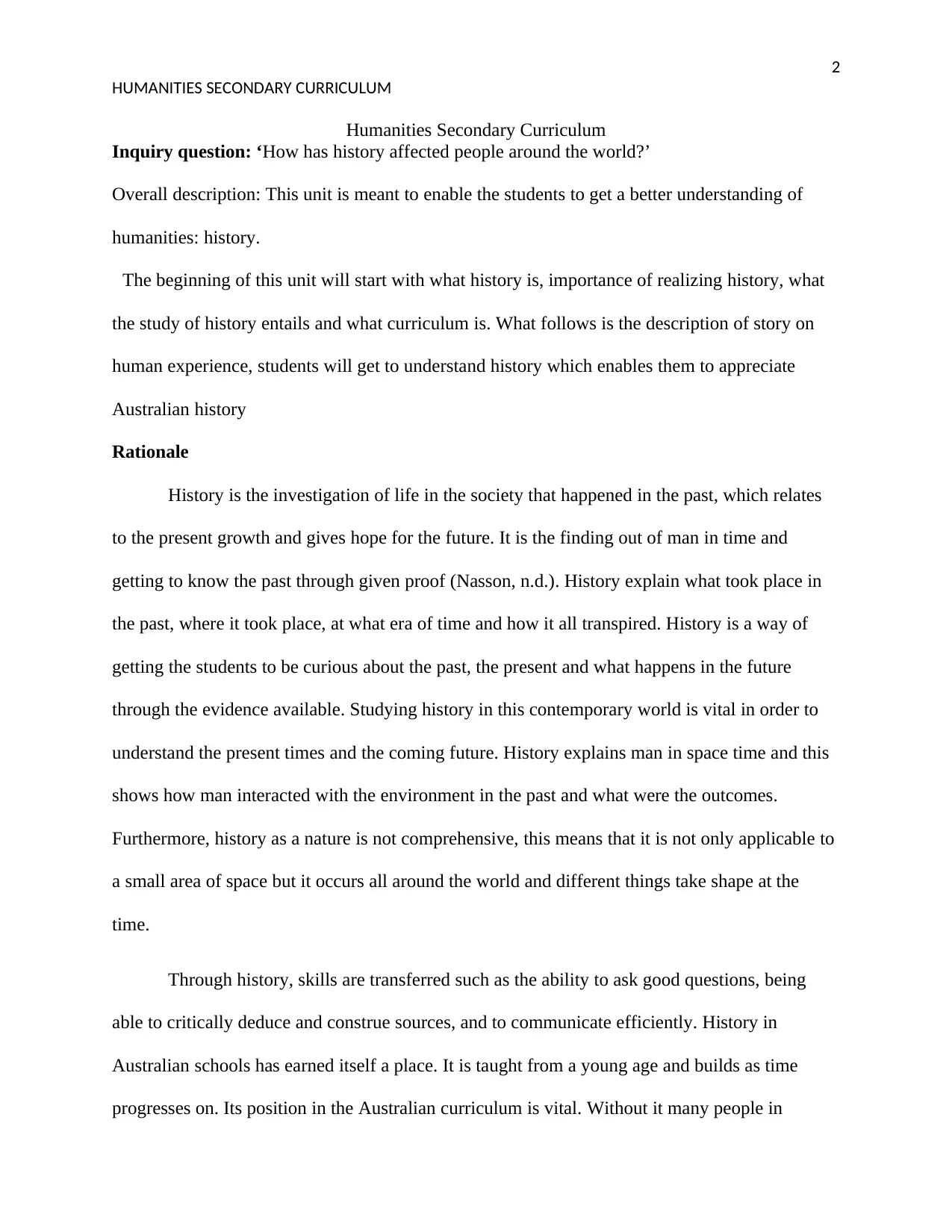
2
HUMANITIES SECONDARY CURRICULUM
Humanities Secondary Curriculum
Inquiry question: ‘How has history affected people around the world?’
Overall description: This unit is meant to enable the students to get a better understanding of
humanities: history.
The beginning of this unit will start with what history is, importance of realizing history, what
the study of history entails and what curriculum is. What follows is the description of story on
human experience, students will get to understand history which enables them to appreciate
Australian history
Rationale
History is the investigation of life in the society that happened in the past, which relates
to the present growth and gives hope for the future. It is the finding out of man in time and
getting to know the past through given proof (Nasson, n.d.). History explain what took place in
the past, where it took place, at what era of time and how it all transpired. History is a way of
getting the students to be curious about the past, the present and what happens in the future
through the evidence available. Studying history in this contemporary world is vital in order to
understand the present times and the coming future. History explains man in space time and this
shows how man interacted with the environment in the past and what were the outcomes.
Furthermore, history as a nature is not comprehensive, this means that it is not only applicable to
a small area of space but it occurs all around the world and different things take shape at the
time.
Through history, skills are transferred such as the ability to ask good questions, being
able to critically deduce and construe sources, and to communicate efficiently. History in
Australian schools has earned itself a place. It is taught from a young age and builds as time
progresses on. Its position in the Australian curriculum is vital. Without it many people in
HUMANITIES SECONDARY CURRICULUM
Humanities Secondary Curriculum
Inquiry question: ‘How has history affected people around the world?’
Overall description: This unit is meant to enable the students to get a better understanding of
humanities: history.
The beginning of this unit will start with what history is, importance of realizing history, what
the study of history entails and what curriculum is. What follows is the description of story on
human experience, students will get to understand history which enables them to appreciate
Australian history
Rationale
History is the investigation of life in the society that happened in the past, which relates
to the present growth and gives hope for the future. It is the finding out of man in time and
getting to know the past through given proof (Nasson, n.d.). History explain what took place in
the past, where it took place, at what era of time and how it all transpired. History is a way of
getting the students to be curious about the past, the present and what happens in the future
through the evidence available. Studying history in this contemporary world is vital in order to
understand the present times and the coming future. History explains man in space time and this
shows how man interacted with the environment in the past and what were the outcomes.
Furthermore, history as a nature is not comprehensive, this means that it is not only applicable to
a small area of space but it occurs all around the world and different things take shape at the
time.
Through history, skills are transferred such as the ability to ask good questions, being
able to critically deduce and construe sources, and to communicate efficiently. History in
Australian schools has earned itself a place. It is taught from a young age and builds as time
progresses on. Its position in the Australian curriculum is vital. Without it many people in

3
HUMANITIES SECONDARY CURRICULUM
Australia would not know about their way of life in the past, they would also miss out in
knowing the world. Through studying history in the perspective of the world, they also get to
appreciate Australian history. Furthermore, it enables them to know the origin of the Aboriginal
and Torres Strait Islander people, their culture and their identity, what gold did to their nation
and when specifically, they attained full independence. They will also get to learn where the
multicultural groups came from and how wars affected Australia. The Australian government has
national declaration of the young in Australia. The government believes that each cohort that
graduates should come out of the learning institutions with more possibilities of succeeding than
the previous group (Barr, Gillard, Firth, Scrymgour, Welford, Lomax-Smith, & Constable,
2008). Moreover, with more students being more successful excelling in school, they will
improve the economic prosperity of the country. Therefore, the government is working with
schools to ensure that students are getting better education. Teaching history thus, enables the
country to attain its national declarations. These young scholars will get to understand their
origin and thus, be united from their young age. The four units in history that will be outlined
here are; finding out about the ancient world, learning about prehistoric societies, learning about
power, people and authority and reforming the ageless world. With all the information that the
students are going to gain, it will help them to live actively in Australia’s distinct associations.
Aims
The following are the aims of Australian Curriculum to the learners;
To enable students to find great interest and enjoyment in studying and working in the
historic fields in and out of Australia.
HUMANITIES SECONDARY CURRICULUM
Australia would not know about their way of life in the past, they would also miss out in
knowing the world. Through studying history in the perspective of the world, they also get to
appreciate Australian history. Furthermore, it enables them to know the origin of the Aboriginal
and Torres Strait Islander people, their culture and their identity, what gold did to their nation
and when specifically, they attained full independence. They will also get to learn where the
multicultural groups came from and how wars affected Australia. The Australian government has
national declaration of the young in Australia. The government believes that each cohort that
graduates should come out of the learning institutions with more possibilities of succeeding than
the previous group (Barr, Gillard, Firth, Scrymgour, Welford, Lomax-Smith, & Constable,
2008). Moreover, with more students being more successful excelling in school, they will
improve the economic prosperity of the country. Therefore, the government is working with
schools to ensure that students are getting better education. Teaching history thus, enables the
country to attain its national declarations. These young scholars will get to understand their
origin and thus, be united from their young age. The four units in history that will be outlined
here are; finding out about the ancient world, learning about prehistoric societies, learning about
power, people and authority and reforming the ageless world. With all the information that the
students are going to gain, it will help them to live actively in Australia’s distinct associations.
Aims
The following are the aims of Australian Curriculum to the learners;
To enable students to find great interest and enjoyment in studying and working in the
historic fields in and out of Australia.
⊘ This is a preview!⊘
Do you want full access?
Subscribe today to unlock all pages.

Trusted by 1+ million students worldwide
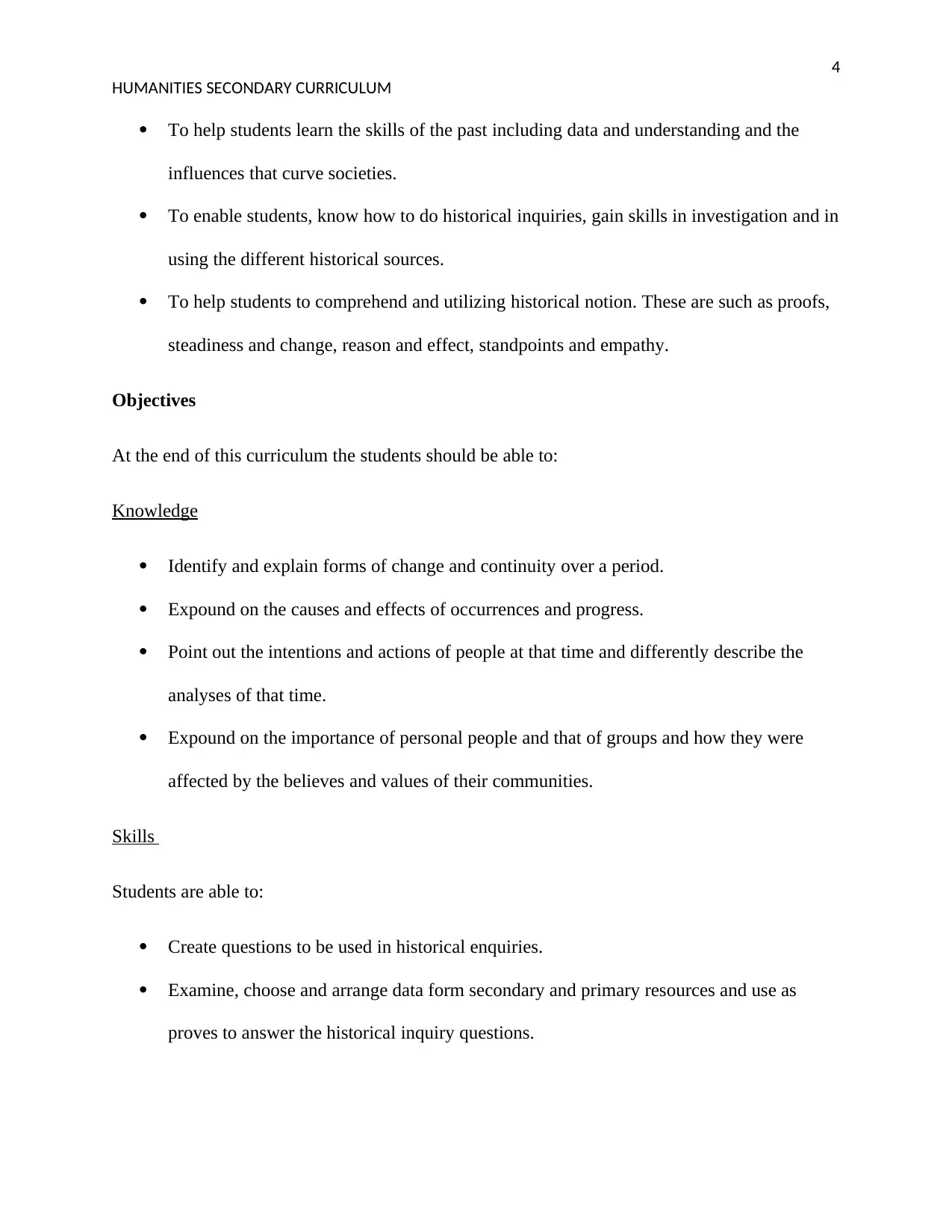
4
HUMANITIES SECONDARY CURRICULUM
To help students learn the skills of the past including data and understanding and the
influences that curve societies.
To enable students, know how to do historical inquiries, gain skills in investigation and in
using the different historical sources.
To help students to comprehend and utilizing historical notion. These are such as proofs,
steadiness and change, reason and effect, standpoints and empathy.
Objectives
At the end of this curriculum the students should be able to:
Knowledge
Identify and explain forms of change and continuity over a period.
Expound on the causes and effects of occurrences and progress.
Point out the intentions and actions of people at that time and differently describe the
analyses of that time.
Expound on the importance of personal people and that of groups and how they were
affected by the believes and values of their communities.
Skills
Students are able to:
Create questions to be used in historical enquiries.
Examine, choose and arrange data form secondary and primary resources and use as
proves to answer the historical inquiry questions.
HUMANITIES SECONDARY CURRICULUM
To help students learn the skills of the past including data and understanding and the
influences that curve societies.
To enable students, know how to do historical inquiries, gain skills in investigation and in
using the different historical sources.
To help students to comprehend and utilizing historical notion. These are such as proofs,
steadiness and change, reason and effect, standpoints and empathy.
Objectives
At the end of this curriculum the students should be able to:
Knowledge
Identify and explain forms of change and continuity over a period.
Expound on the causes and effects of occurrences and progress.
Point out the intentions and actions of people at that time and differently describe the
analyses of that time.
Expound on the importance of personal people and that of groups and how they were
affected by the believes and values of their communities.
Skills
Students are able to:
Create questions to be used in historical enquiries.
Examine, choose and arrange data form secondary and primary resources and use as
proves to answer the historical inquiry questions.
Paraphrase This Document
Need a fresh take? Get an instant paraphrase of this document with our AI Paraphraser
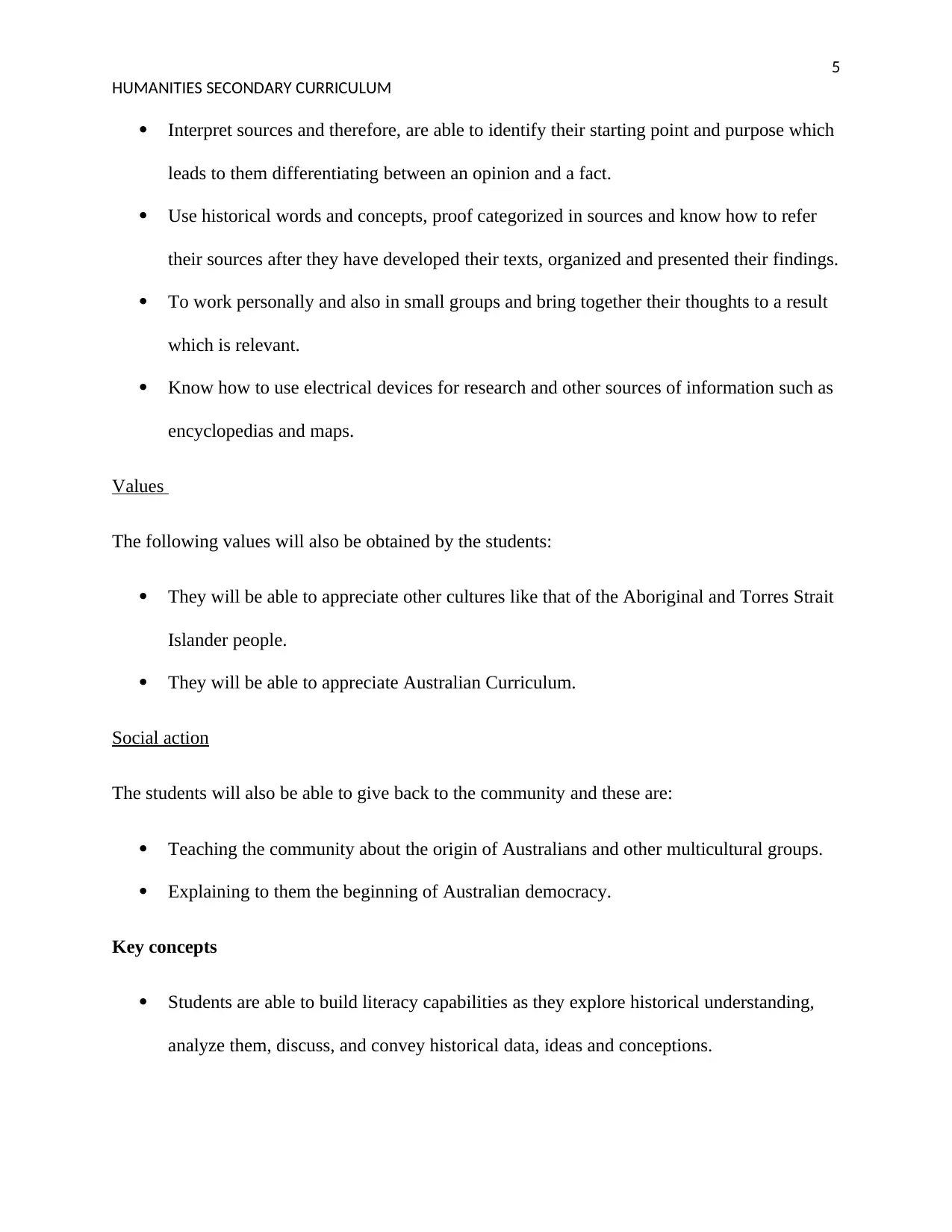
5
HUMANITIES SECONDARY CURRICULUM
Interpret sources and therefore, are able to identify their starting point and purpose which
leads to them differentiating between an opinion and a fact.
Use historical words and concepts, proof categorized in sources and know how to refer
their sources after they have developed their texts, organized and presented their findings.
To work personally and also in small groups and bring together their thoughts to a result
which is relevant.
Know how to use electrical devices for research and other sources of information such as
encyclopedias and maps.
Values
The following values will also be obtained by the students:
They will be able to appreciate other cultures like that of the Aboriginal and Torres Strait
Islander people.
They will be able to appreciate Australian Curriculum.
Social action
The students will also be able to give back to the community and these are:
Teaching the community about the origin of Australians and other multicultural groups.
Explaining to them the beginning of Australian democracy.
Key concepts
Students are able to build literacy capabilities as they explore historical understanding,
analyze them, discuss, and convey historical data, ideas and conceptions.
HUMANITIES SECONDARY CURRICULUM
Interpret sources and therefore, are able to identify their starting point and purpose which
leads to them differentiating between an opinion and a fact.
Use historical words and concepts, proof categorized in sources and know how to refer
their sources after they have developed their texts, organized and presented their findings.
To work personally and also in small groups and bring together their thoughts to a result
which is relevant.
Know how to use electrical devices for research and other sources of information such as
encyclopedias and maps.
Values
The following values will also be obtained by the students:
They will be able to appreciate other cultures like that of the Aboriginal and Torres Strait
Islander people.
They will be able to appreciate Australian Curriculum.
Social action
The students will also be able to give back to the community and these are:
Teaching the community about the origin of Australians and other multicultural groups.
Explaining to them the beginning of Australian democracy.
Key concepts
Students are able to build literacy capabilities as they explore historical understanding,
analyze them, discuss, and convey historical data, ideas and conceptions.
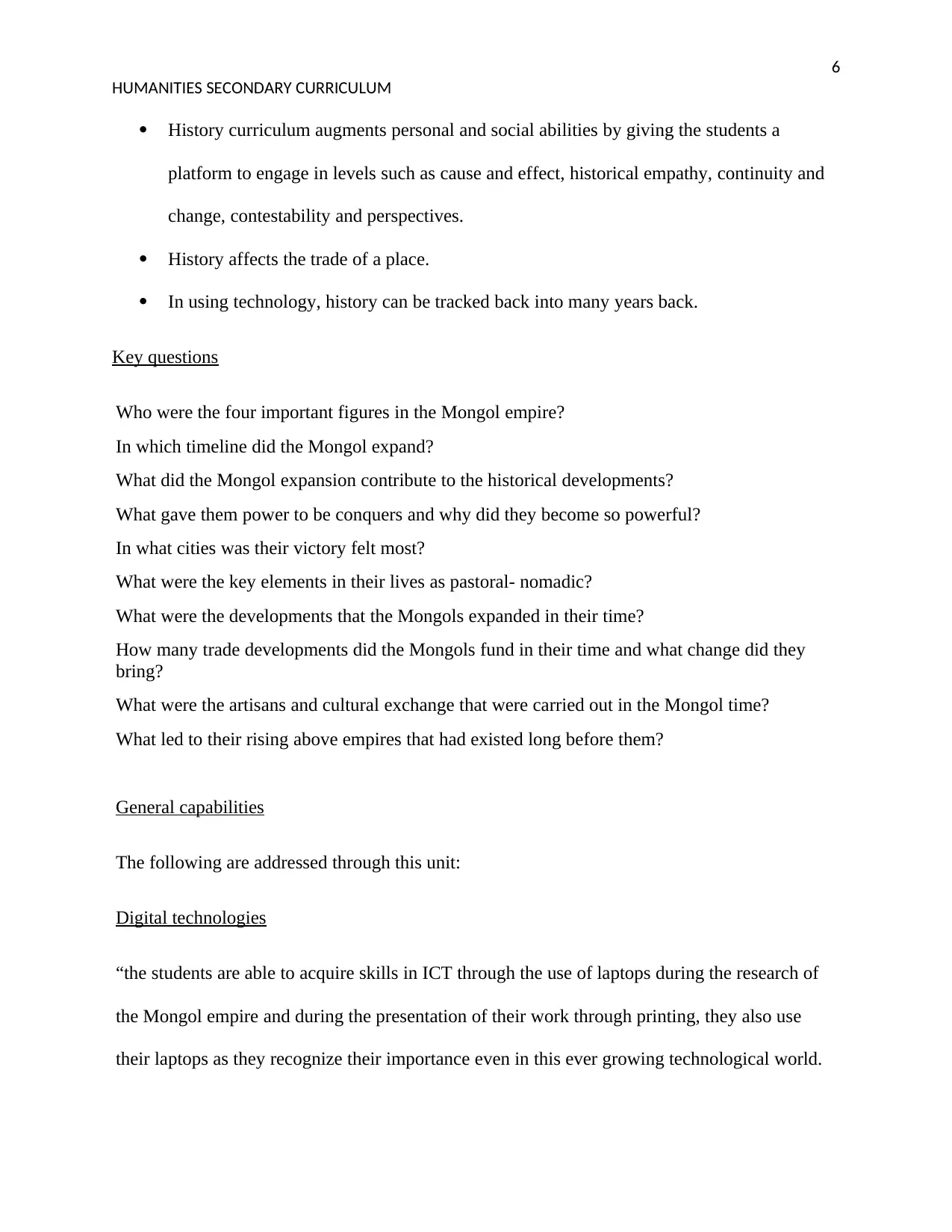
6
HUMANITIES SECONDARY CURRICULUM
History curriculum augments personal and social abilities by giving the students a
platform to engage in levels such as cause and effect, historical empathy, continuity and
change, contestability and perspectives.
History affects the trade of a place.
In using technology, history can be tracked back into many years back.
Key questions
Who were the four important figures in the Mongol empire?
In which timeline did the Mongol expand?
What did the Mongol expansion contribute to the historical developments?
What gave them power to be conquers and why did they become so powerful?
In what cities was their victory felt most?
What were the key elements in their lives as pastoral- nomadic?
What were the developments that the Mongols expanded in their time?
How many trade developments did the Mongols fund in their time and what change did they
bring?
What were the artisans and cultural exchange that were carried out in the Mongol time?
What led to their rising above empires that had existed long before them?
General capabilities
The following are addressed through this unit:
Digital technologies
“the students are able to acquire skills in ICT through the use of laptops during the research of
the Mongol empire and during the presentation of their work through printing, they also use
their laptops as they recognize their importance even in this ever growing technological world.
HUMANITIES SECONDARY CURRICULUM
History curriculum augments personal and social abilities by giving the students a
platform to engage in levels such as cause and effect, historical empathy, continuity and
change, contestability and perspectives.
History affects the trade of a place.
In using technology, history can be tracked back into many years back.
Key questions
Who were the four important figures in the Mongol empire?
In which timeline did the Mongol expand?
What did the Mongol expansion contribute to the historical developments?
What gave them power to be conquers and why did they become so powerful?
In what cities was their victory felt most?
What were the key elements in their lives as pastoral- nomadic?
What were the developments that the Mongols expanded in their time?
How many trade developments did the Mongols fund in their time and what change did they
bring?
What were the artisans and cultural exchange that were carried out in the Mongol time?
What led to their rising above empires that had existed long before them?
General capabilities
The following are addressed through this unit:
Digital technologies
“the students are able to acquire skills in ICT through the use of laptops during the research of
the Mongol empire and during the presentation of their work through printing, they also use
their laptops as they recognize their importance even in this ever growing technological world.
⊘ This is a preview!⊘
Do you want full access?
Subscribe today to unlock all pages.

Trusted by 1+ million students worldwide
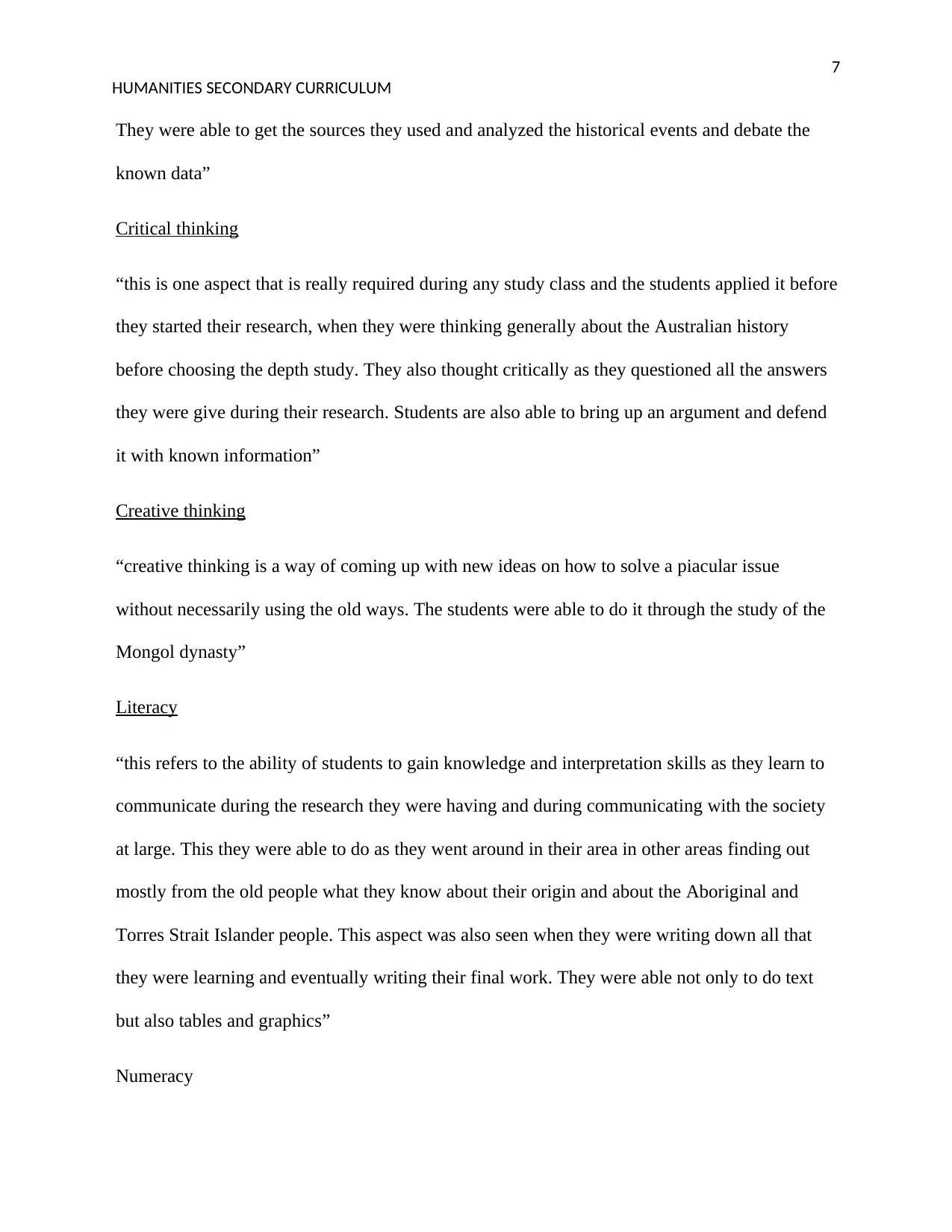
7
HUMANITIES SECONDARY CURRICULUM
They were able to get the sources they used and analyzed the historical events and debate the
known data”
Critical thinking
“this is one aspect that is really required during any study class and the students applied it before
they started their research, when they were thinking generally about the Australian history
before choosing the depth study. They also thought critically as they questioned all the answers
they were give during their research. Students are also able to bring up an argument and defend
it with known information”
Creative thinking
“creative thinking is a way of coming up with new ideas on how to solve a piacular issue
without necessarily using the old ways. The students were able to do it through the study of the
Mongol dynasty”
Literacy
“this refers to the ability of students to gain knowledge and interpretation skills as they learn to
communicate during the research they were having and during communicating with the society
at large. This they were able to do as they went around in their area in other areas finding out
mostly from the old people what they know about their origin and about the Aboriginal and
Torres Strait Islander people. This aspect was also seen when they were writing down all that
they were learning and eventually writing their final work. They were able not only to do text
but also tables and graphics”
Numeracy
HUMANITIES SECONDARY CURRICULUM
They were able to get the sources they used and analyzed the historical events and debate the
known data”
Critical thinking
“this is one aspect that is really required during any study class and the students applied it before
they started their research, when they were thinking generally about the Australian history
before choosing the depth study. They also thought critically as they questioned all the answers
they were give during their research. Students are also able to bring up an argument and defend
it with known information”
Creative thinking
“creative thinking is a way of coming up with new ideas on how to solve a piacular issue
without necessarily using the old ways. The students were able to do it through the study of the
Mongol dynasty”
Literacy
“this refers to the ability of students to gain knowledge and interpretation skills as they learn to
communicate during the research they were having and during communicating with the society
at large. This they were able to do as they went around in their area in other areas finding out
mostly from the old people what they know about their origin and about the Aboriginal and
Torres Strait Islander people. This aspect was also seen when they were writing down all that
they were learning and eventually writing their final work. They were able not only to do text
but also tables and graphics”
Numeracy
Paraphrase This Document
Need a fresh take? Get an instant paraphrase of this document with our AI Paraphraser
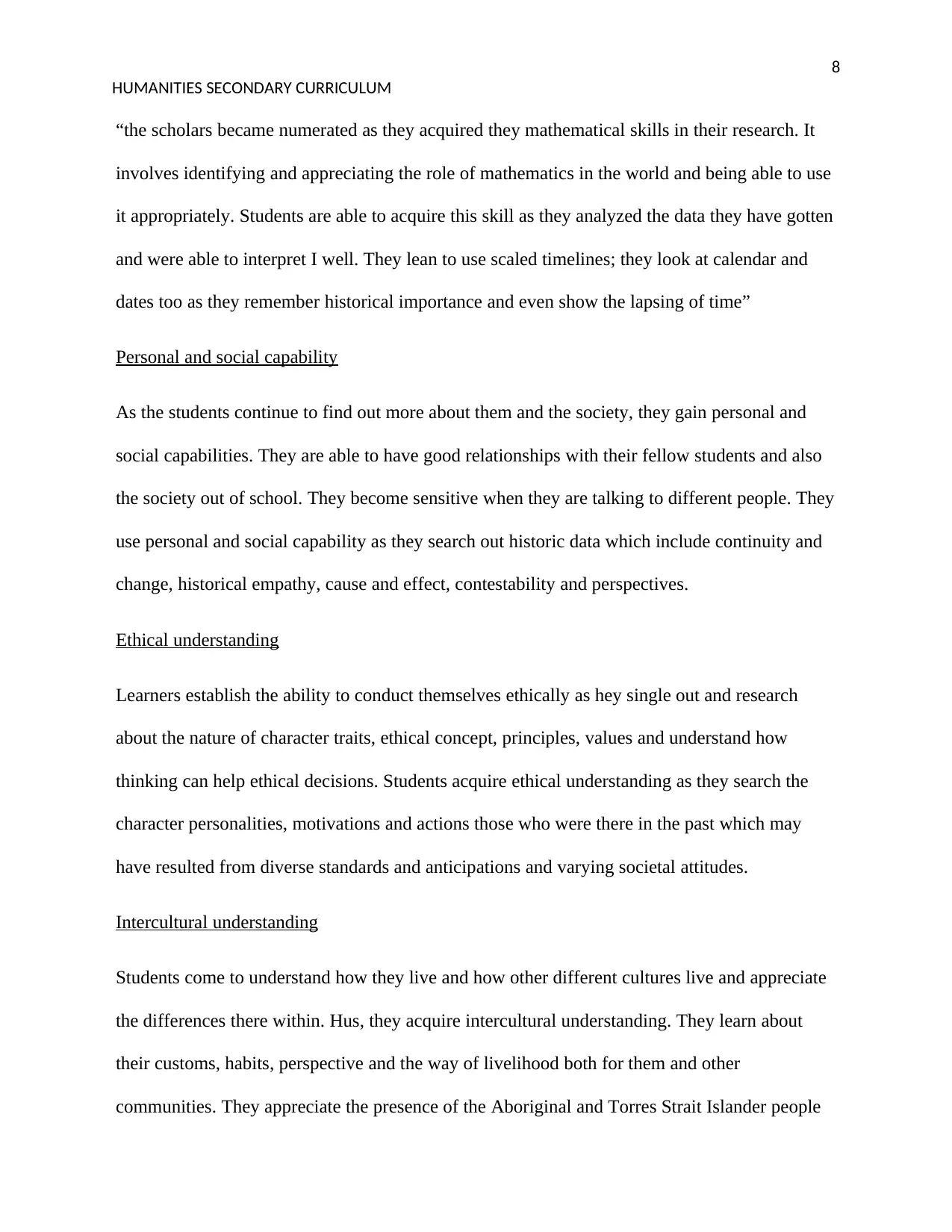
8
HUMANITIES SECONDARY CURRICULUM
“the scholars became numerated as they acquired they mathematical skills in their research. It
involves identifying and appreciating the role of mathematics in the world and being able to use
it appropriately. Students are able to acquire this skill as they analyzed the data they have gotten
and were able to interpret I well. They lean to use scaled timelines; they look at calendar and
dates too as they remember historical importance and even show the lapsing of time”
Personal and social capability
As the students continue to find out more about them and the society, they gain personal and
social capabilities. They are able to have good relationships with their fellow students and also
the society out of school. They become sensitive when they are talking to different people. They
use personal and social capability as they search out historic data which include continuity and
change, historical empathy, cause and effect, contestability and perspectives.
Ethical understanding
Learners establish the ability to conduct themselves ethically as hey single out and research
about the nature of character traits, ethical concept, principles, values and understand how
thinking can help ethical decisions. Students acquire ethical understanding as they search the
character personalities, motivations and actions those who were there in the past which may
have resulted from diverse standards and anticipations and varying societal attitudes.
Intercultural understanding
Students come to understand how they live and how other different cultures live and appreciate
the differences there within. Hus, they acquire intercultural understanding. They learn about
their customs, habits, perspective and the way of livelihood both for them and other
communities. They appreciate the presence of the Aboriginal and Torres Strait Islander people
HUMANITIES SECONDARY CURRICULUM
“the scholars became numerated as they acquired they mathematical skills in their research. It
involves identifying and appreciating the role of mathematics in the world and being able to use
it appropriately. Students are able to acquire this skill as they analyzed the data they have gotten
and were able to interpret I well. They lean to use scaled timelines; they look at calendar and
dates too as they remember historical importance and even show the lapsing of time”
Personal and social capability
As the students continue to find out more about them and the society, they gain personal and
social capabilities. They are able to have good relationships with their fellow students and also
the society out of school. They become sensitive when they are talking to different people. They
use personal and social capability as they search out historic data which include continuity and
change, historical empathy, cause and effect, contestability and perspectives.
Ethical understanding
Learners establish the ability to conduct themselves ethically as hey single out and research
about the nature of character traits, ethical concept, principles, values and understand how
thinking can help ethical decisions. Students acquire ethical understanding as they search the
character personalities, motivations and actions those who were there in the past which may
have resulted from diverse standards and anticipations and varying societal attitudes.
Intercultural understanding
Students come to understand how they live and how other different cultures live and appreciate
the differences there within. Hus, they acquire intercultural understanding. They learn about
their customs, habits, perspective and the way of livelihood both for them and other
communities. They appreciate the presence of the Aboriginal and Torres Strait Islander people
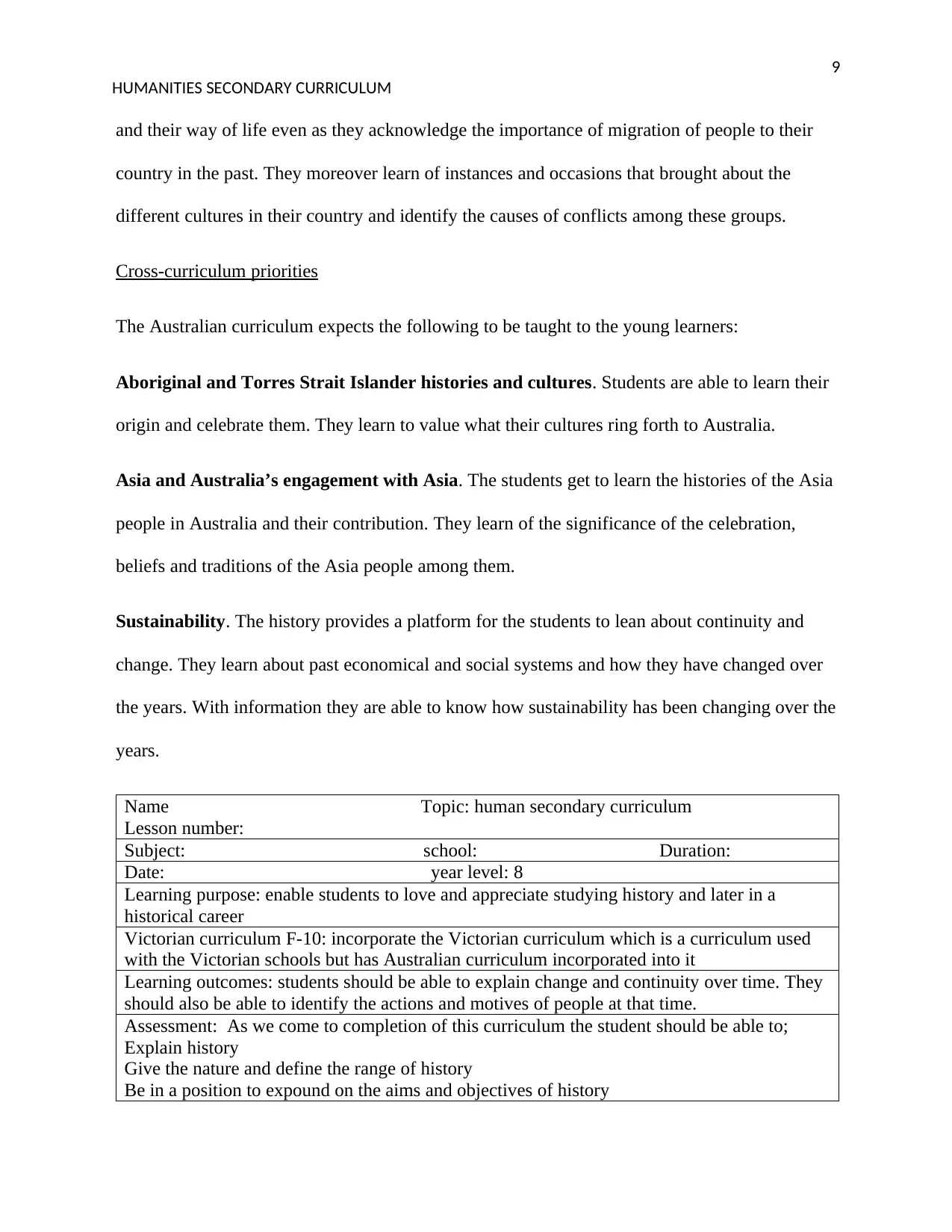
9
HUMANITIES SECONDARY CURRICULUM
and their way of life even as they acknowledge the importance of migration of people to their
country in the past. They moreover learn of instances and occasions that brought about the
different cultures in their country and identify the causes of conflicts among these groups.
Cross-curriculum priorities
The Australian curriculum expects the following to be taught to the young learners:
Aboriginal and Torres Strait Islander histories and cultures. Students are able to learn their
origin and celebrate them. They learn to value what their cultures ring forth to Australia.
Asia and Australia’s engagement with Asia. The students get to learn the histories of the Asia
people in Australia and their contribution. They learn of the significance of the celebration,
beliefs and traditions of the Asia people among them.
Sustainability. The history provides a platform for the students to lean about continuity and
change. They learn about past economical and social systems and how they have changed over
the years. With information they are able to know how sustainability has been changing over the
years.
Name Topic: human secondary curriculum
Lesson number:
Subject: school: Duration:
Date: year level: 8
Learning purpose: enable students to love and appreciate studying history and later in a
historical career
Victorian curriculum F-10: incorporate the Victorian curriculum which is a curriculum used
with the Victorian schools but has Australian curriculum incorporated into it
Learning outcomes: students should be able to explain change and continuity over time. They
should also be able to identify the actions and motives of people at that time.
Assessment: As we come to completion of this curriculum the student should be able to;
Explain history
Give the nature and define the range of history
Be in a position to expound on the aims and objectives of history
HUMANITIES SECONDARY CURRICULUM
and their way of life even as they acknowledge the importance of migration of people to their
country in the past. They moreover learn of instances and occasions that brought about the
different cultures in their country and identify the causes of conflicts among these groups.
Cross-curriculum priorities
The Australian curriculum expects the following to be taught to the young learners:
Aboriginal and Torres Strait Islander histories and cultures. Students are able to learn their
origin and celebrate them. They learn to value what their cultures ring forth to Australia.
Asia and Australia’s engagement with Asia. The students get to learn the histories of the Asia
people in Australia and their contribution. They learn of the significance of the celebration,
beliefs and traditions of the Asia people among them.
Sustainability. The history provides a platform for the students to lean about continuity and
change. They learn about past economical and social systems and how they have changed over
the years. With information they are able to know how sustainability has been changing over the
years.
Name Topic: human secondary curriculum
Lesson number:
Subject: school: Duration:
Date: year level: 8
Learning purpose: enable students to love and appreciate studying history and later in a
historical career
Victorian curriculum F-10: incorporate the Victorian curriculum which is a curriculum used
with the Victorian schools but has Australian curriculum incorporated into it
Learning outcomes: students should be able to explain change and continuity over time. They
should also be able to identify the actions and motives of people at that time.
Assessment: As we come to completion of this curriculum the student should be able to;
Explain history
Give the nature and define the range of history
Be in a position to expound on the aims and objectives of history
⊘ This is a preview!⊘
Do you want full access?
Subscribe today to unlock all pages.

Trusted by 1+ million students worldwide
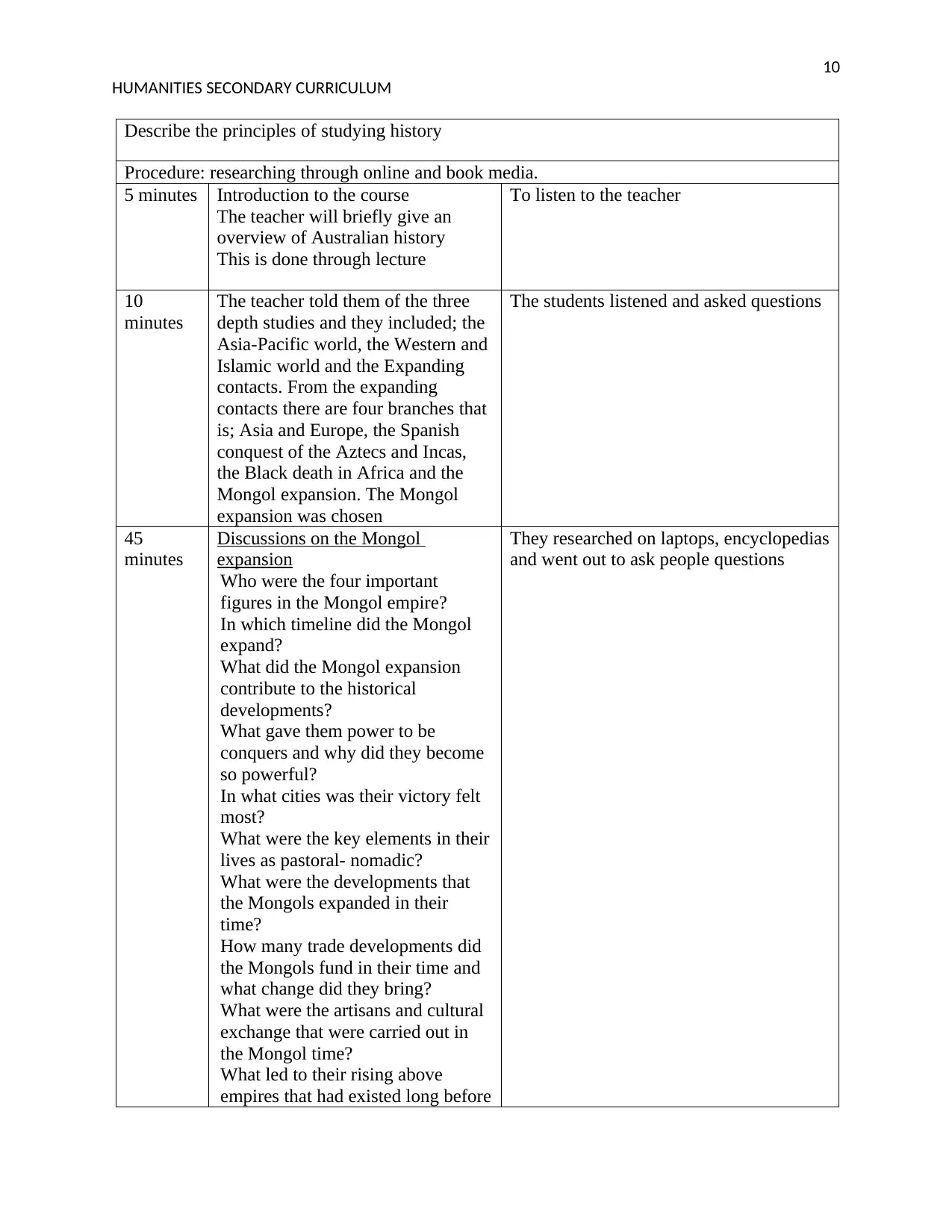
10
HUMANITIES SECONDARY CURRICULUM
Describe the principles of studying history
Procedure: researching through online and book media.
5 minutes Introduction to the course
The teacher will briefly give an
overview of Australian history
This is done through lecture
To listen to the teacher
10
minutes
The teacher told them of the three
depth studies and they included; the
Asia-Pacific world, the Western and
Islamic world and the Expanding
contacts. From the expanding
contacts there are four branches that
is; Asia and Europe, the Spanish
conquest of the Aztecs and Incas,
the Black death in Africa and the
Mongol expansion. The Mongol
expansion was chosen
The students listened and asked questions
45
minutes
Discussions on the Mongol
expansion
Who were the four important
figures in the Mongol empire?
In which timeline did the Mongol
expand?
What did the Mongol expansion
contribute to the historical
developments?
What gave them power to be
conquers and why did they become
so powerful?
In what cities was their victory felt
most?
What were the key elements in their
lives as pastoral- nomadic?
What were the developments that
the Mongols expanded in their
time?
How many trade developments did
the Mongols fund in their time and
what change did they bring?
What were the artisans and cultural
exchange that were carried out in
the Mongol time?
What led to their rising above
empires that had existed long before
They researched on laptops, encyclopedias
and went out to ask people questions
HUMANITIES SECONDARY CURRICULUM
Describe the principles of studying history
Procedure: researching through online and book media.
5 minutes Introduction to the course
The teacher will briefly give an
overview of Australian history
This is done through lecture
To listen to the teacher
10
minutes
The teacher told them of the three
depth studies and they included; the
Asia-Pacific world, the Western and
Islamic world and the Expanding
contacts. From the expanding
contacts there are four branches that
is; Asia and Europe, the Spanish
conquest of the Aztecs and Incas,
the Black death in Africa and the
Mongol expansion. The Mongol
expansion was chosen
The students listened and asked questions
45
minutes
Discussions on the Mongol
expansion
Who were the four important
figures in the Mongol empire?
In which timeline did the Mongol
expand?
What did the Mongol expansion
contribute to the historical
developments?
What gave them power to be
conquers and why did they become
so powerful?
In what cities was their victory felt
most?
What were the key elements in their
lives as pastoral- nomadic?
What were the developments that
the Mongols expanded in their
time?
How many trade developments did
the Mongols fund in their time and
what change did they bring?
What were the artisans and cultural
exchange that were carried out in
the Mongol time?
What led to their rising above
empires that had existed long before
They researched on laptops, encyclopedias
and went out to ask people questions
Paraphrase This Document
Need a fresh take? Get an instant paraphrase of this document with our AI Paraphraser
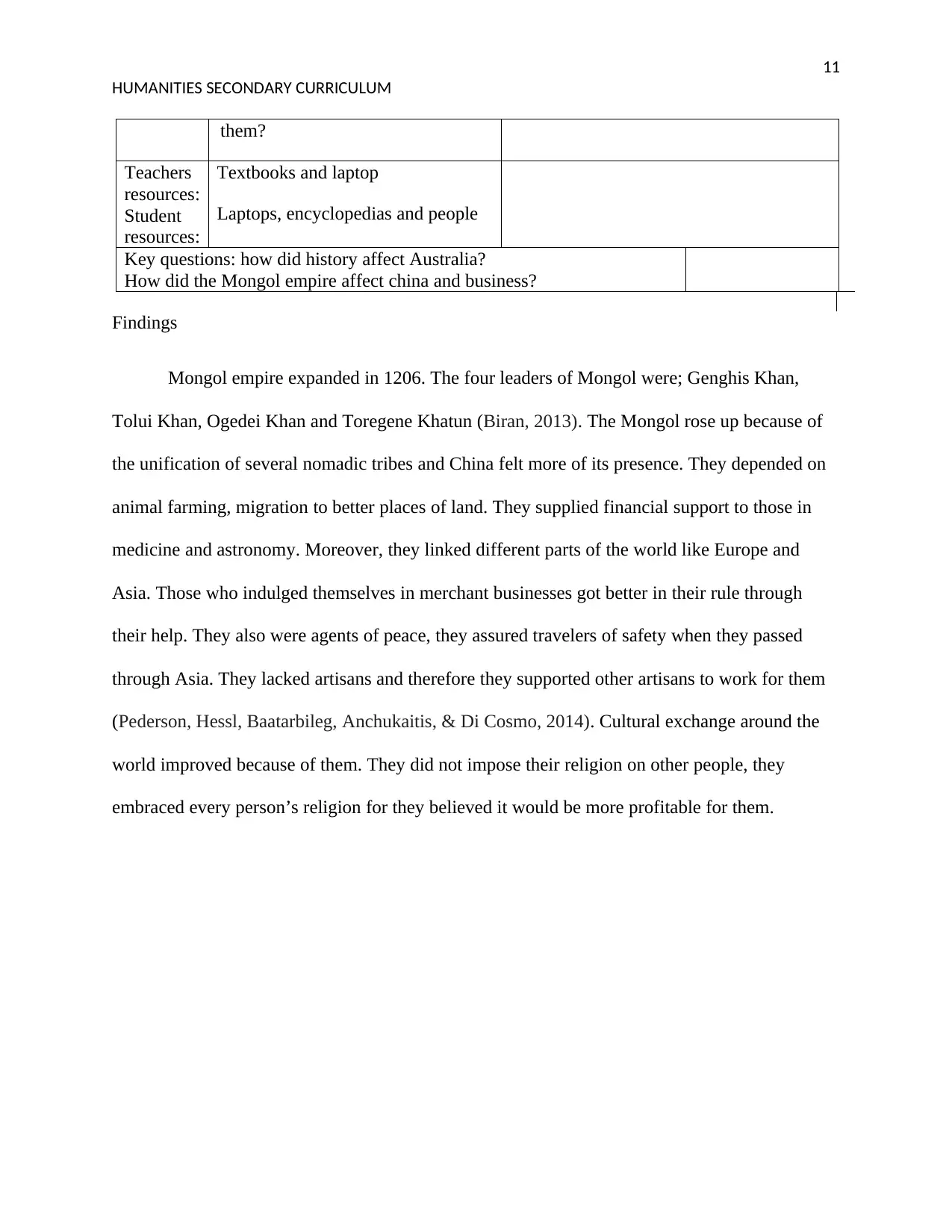
11
HUMANITIES SECONDARY CURRICULUM
them?
Teachers
resources:
Student
resources:
Textbooks and laptop
Laptops, encyclopedias and people
Key questions: how did history affect Australia?
How did the Mongol empire affect china and business?
Findings
Mongol empire expanded in 1206. The four leaders of Mongol were; Genghis Khan,
Tolui Khan, Ogedei Khan and Toregene Khatun (Biran, 2013). The Mongol rose up because of
the unification of several nomadic tribes and China felt more of its presence. They depended on
animal farming, migration to better places of land. They supplied financial support to those in
medicine and astronomy. Moreover, they linked different parts of the world like Europe and
Asia. Those who indulged themselves in merchant businesses got better in their rule through
their help. They also were agents of peace, they assured travelers of safety when they passed
through Asia. They lacked artisans and therefore they supported other artisans to work for them
(Pederson, Hessl, Baatarbileg, Anchukaitis, & Di Cosmo, 2014). Cultural exchange around the
world improved because of them. They did not impose their religion on other people, they
embraced every person’s religion for they believed it would be more profitable for them.
HUMANITIES SECONDARY CURRICULUM
them?
Teachers
resources:
Student
resources:
Textbooks and laptop
Laptops, encyclopedias and people
Key questions: how did history affect Australia?
How did the Mongol empire affect china and business?
Findings
Mongol empire expanded in 1206. The four leaders of Mongol were; Genghis Khan,
Tolui Khan, Ogedei Khan and Toregene Khatun (Biran, 2013). The Mongol rose up because of
the unification of several nomadic tribes and China felt more of its presence. They depended on
animal farming, migration to better places of land. They supplied financial support to those in
medicine and astronomy. Moreover, they linked different parts of the world like Europe and
Asia. Those who indulged themselves in merchant businesses got better in their rule through
their help. They also were agents of peace, they assured travelers of safety when they passed
through Asia. They lacked artisans and therefore they supported other artisans to work for them
(Pederson, Hessl, Baatarbileg, Anchukaitis, & Di Cosmo, 2014). Cultural exchange around the
world improved because of them. They did not impose their religion on other people, they
embraced every person’s religion for they believed it would be more profitable for them.
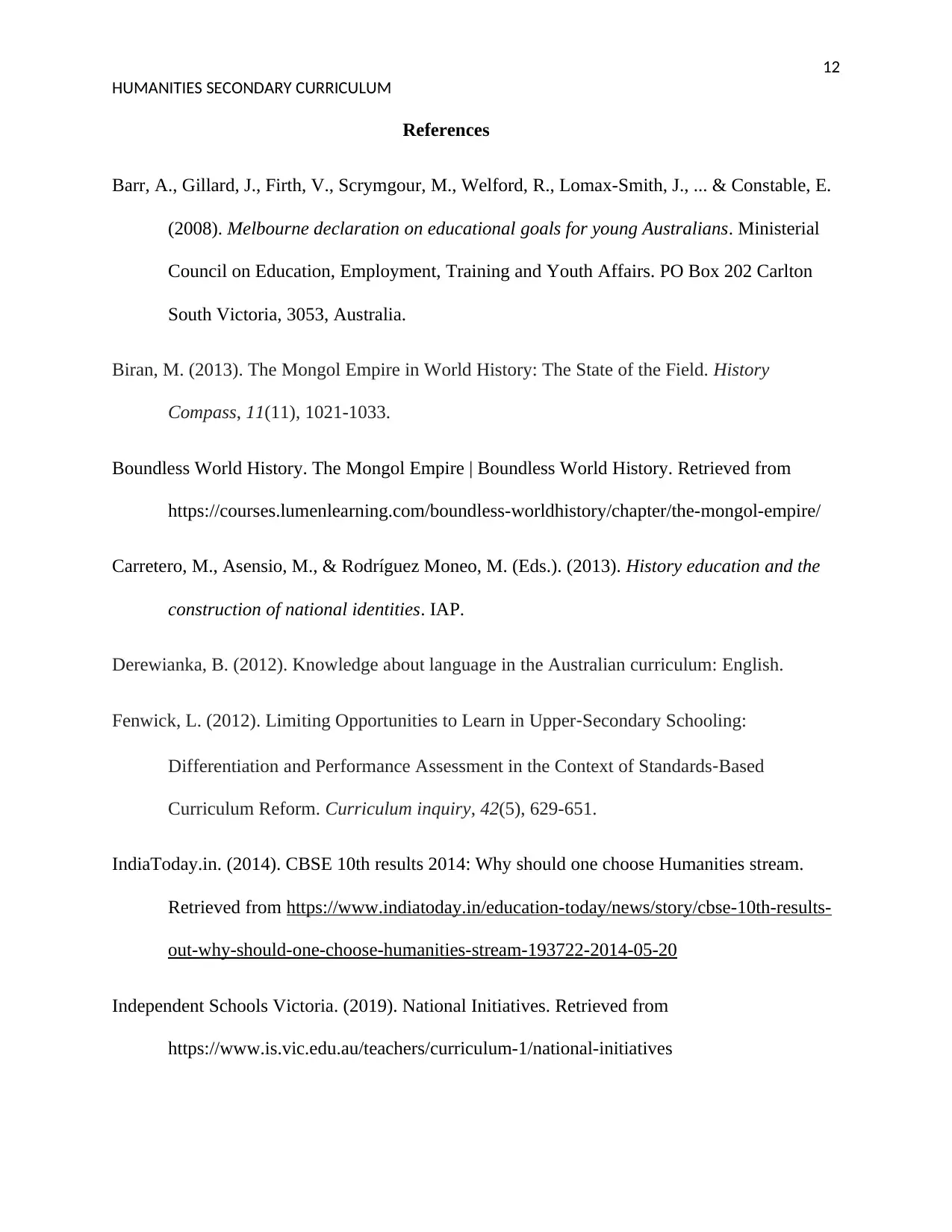
12
HUMANITIES SECONDARY CURRICULUM
References
Barr, A., Gillard, J., Firth, V., Scrymgour, M., Welford, R., Lomax-Smith, J., ... & Constable, E.
(2008). Melbourne declaration on educational goals for young Australians. Ministerial
Council on Education, Employment, Training and Youth Affairs. PO Box 202 Carlton
South Victoria, 3053, Australia.
Biran, M. (2013). The Mongol Empire in World History: The State of the Field. History
Compass, 11(11), 1021-1033.
Boundless World History. The Mongol Empire | Boundless World History. Retrieved from
https://courses.lumenlearning.com/boundless-worldhistory/chapter/the-mongol-empire/
Carretero, M., Asensio, M., & Rodríguez Moneo, M. (Eds.). (2013). History education and the
construction of national identities. IAP.
Derewianka, B. (2012). Knowledge about language in the Australian curriculum: English.
Fenwick, L. (2012). Limiting Opportunities to Learn in Upper‐Secondary Schooling:
Differentiation and Performance Assessment in the Context of Standards‐Based
Curriculum Reform. Curriculum inquiry, 42(5), 629-651.
IndiaToday.in. (2014). CBSE 10th results 2014: Why should one choose Humanities stream.
Retrieved from https://www.indiatoday.in/education-today/news/story/cbse-10th-results-
out-why-should-one-choose-humanities-stream-193722-2014-05-20
Independent Schools Victoria. (2019). National Initiatives. Retrieved from
https://www.is.vic.edu.au/teachers/curriculum-1/national-initiatives
HUMANITIES SECONDARY CURRICULUM
References
Barr, A., Gillard, J., Firth, V., Scrymgour, M., Welford, R., Lomax-Smith, J., ... & Constable, E.
(2008). Melbourne declaration on educational goals for young Australians. Ministerial
Council on Education, Employment, Training and Youth Affairs. PO Box 202 Carlton
South Victoria, 3053, Australia.
Biran, M. (2013). The Mongol Empire in World History: The State of the Field. History
Compass, 11(11), 1021-1033.
Boundless World History. The Mongol Empire | Boundless World History. Retrieved from
https://courses.lumenlearning.com/boundless-worldhistory/chapter/the-mongol-empire/
Carretero, M., Asensio, M., & Rodríguez Moneo, M. (Eds.). (2013). History education and the
construction of national identities. IAP.
Derewianka, B. (2012). Knowledge about language in the Australian curriculum: English.
Fenwick, L. (2012). Limiting Opportunities to Learn in Upper‐Secondary Schooling:
Differentiation and Performance Assessment in the Context of Standards‐Based
Curriculum Reform. Curriculum inquiry, 42(5), 629-651.
IndiaToday.in. (2014). CBSE 10th results 2014: Why should one choose Humanities stream.
Retrieved from https://www.indiatoday.in/education-today/news/story/cbse-10th-results-
out-why-should-one-choose-humanities-stream-193722-2014-05-20
Independent Schools Victoria. (2019). National Initiatives. Retrieved from
https://www.is.vic.edu.au/teachers/curriculum-1/national-initiatives
⊘ This is a preview!⊘
Do you want full access?
Subscribe today to unlock all pages.

Trusted by 1+ million students worldwide
1 out of 13
Related Documents
Your All-in-One AI-Powered Toolkit for Academic Success.
+13062052269
info@desklib.com
Available 24*7 on WhatsApp / Email
![[object Object]](/_next/static/media/star-bottom.7253800d.svg)
Unlock your academic potential
Copyright © 2020–2025 A2Z Services. All Rights Reserved. Developed and managed by ZUCOL.





